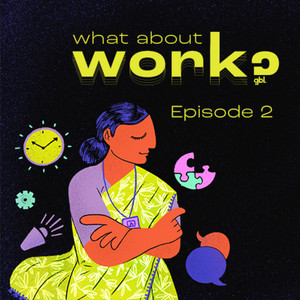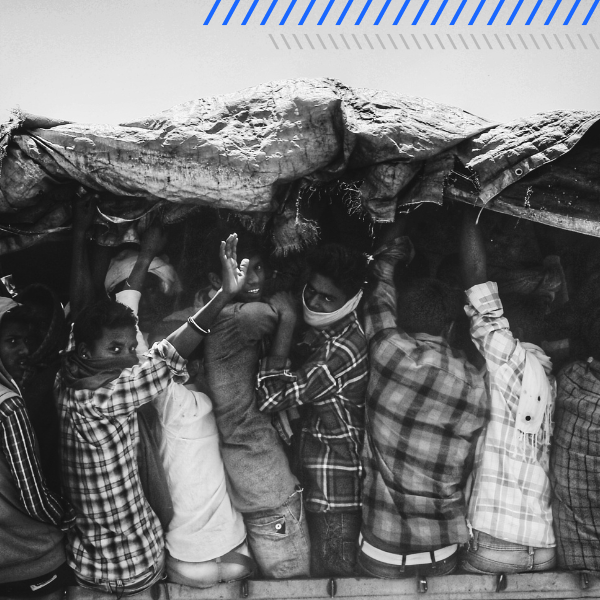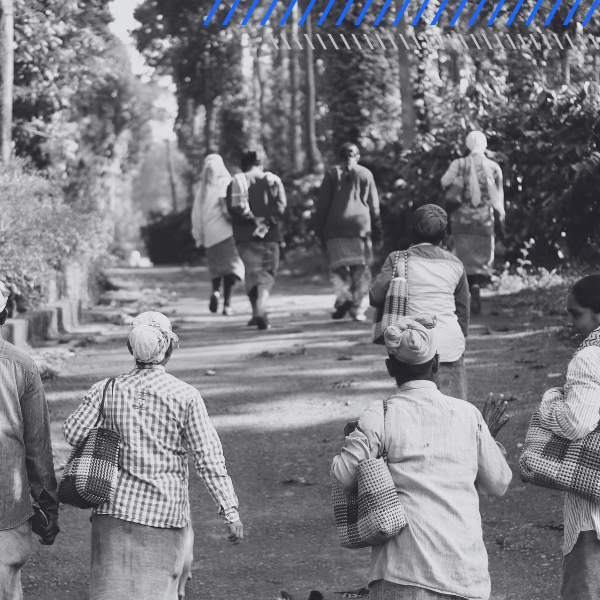In this introductory episode, we turn to history to share insights into the past lives of labor. We do that by briefly diving into the evolution of the garment manufacturing industry and what it has meant to the workers within this sector, then and now! We discuss the displacement of spinning and weaving post the industrial revolution, the historical gendered division of garment labor, and how the lives of countless women across South Asia are delicately woven into it.
Transcript
Calcutta. The year is 1828. The sound of a ship. Another ship has pulled into the bustling port *Market sounds* bringing with it: Hams and figs. Ale. Madeira glasses. Perfumes. Jewelry. And so, so much more. Some of these will be lavishly furnished in the homes of colonial officials. Others will be adorned by the native creme da la creme of British India. Even more, will traverse the waters to places far beyond Calcutta.
*Birds, rain, trees*
As the boat curved into the city’s shores, a hundred kilometers away, in a small village, one widow *footsteps shuffling* returned to her home. She had just posted a letter to a newspaper, Samachar Darpan. A letter that is so much more than just her story.
We will return to the letter. And to her. Her, who I have named in my heart, Shanti.
But that ship docking at Calcutta’s port was a testament to a changing world order. It carried cloth. Cloth was now an import to India. Global trade had begun to shift.
*Intro music*
Hello! You’re listening to What about work? An audio series produced by Good Business Lab.
Good Business Lab seeks to globally transform the lives of low-income workers through rigorous research and evidence-based solutions.
What about work addresses the experiences, both past and present, of workers in labor-intensive industries and other emerging sectors across geographies. Be it garment, automobile, fast food, or platform gig work.
*Fade intro music*
Our first episode is on the garment sector. How it has changed. How it hasn’t. And how the lives of countless women across South Asia are delicately woven to it.
A French missionary who lived in southern India’s Madras Presidency during the early 19th century, Abbe Dubois found Typewriter sounds countless widows and other women out of work and consequently destitute who used to maintain their families by cotton spinning.
A headmaster of a weaving station and the Industries Department Surveyor for the Crown, J M Cook said of Shahjahanpur, Sounds of a household weaving loom
Here, as in other places, the women folk take a large share in producing the cloth. Even when the male member of a family was weaving on a fly-shuttle loom, I noticed there were also household looms on which the women weave.
That was in 1911. Today, Shahjahanpur comes under the northern state of Uttar Pradesh.
What these two accounts show is that women were often engaged in certain cloth production processes. There may have been differences in how they carried out their labor as opposed to men, weaving at home being one big one. Still, they depended on industries of fabric for sustenance.
But then English yarn began flooding the global supply chain. Raw cotton was siphoned out of India, Egypt, And America. Yarn was pumped back in.
Two years before Shanti sent her letter to Samachar Darpan, 1 hundred million pounds in weight of cotton was exported from British India. But to understand why that number is shocking, let us rewind a bit. In the 9 years between 1789 and 1798, less than half a million of cotton was exported. Then in just one year of 1826, 1 hundred million. And it didn’t stop there. Exports tripled by 1860. And after 6 years had risen to a staggering 7 hundred and 50 million pounds of cotton.
Spinning and weaving became unprofitable. They were now outsourced. The empire of cotton had succeeded in displacing countless women.
Women like Shanti.
*Running water, crops, livestock, and rain*
The application of a spinner from Shantipur Nadia. I have married off three daughters, arranged my father-in-law’s funeral, and taken care of my natal family, all on my own, mind you. How after all this do I now have no means of livelihood? The weavers have stopped collecting from my house. I pray to the spinners of England. Take pity.
That was Shanti’s letter. At least what I imagine it would say. Her story was mentioned in a footnote. A footnote in a gutting paper by Ratnabali Chatterjee. A footnote that has endlessly fascinated me. And that has seamlessly captured how colonialism restitched local economies.
What these stories of dispossession also show is that women were critical to the production of cloth. Capital needed them. And administrators learnt this in surprising ways.
Historian Santosh Kumar Rai speaks in a recent article of Moradabad which today lies 200 kilometers almost directly east of New Delhi. English officials in the district introduced a government training program in 1911, the same year that J M Cook was touring a different part of the region if you remember! The program would educate weavers on the modern machine looms and shift the site of production from the domestic or workshop model to the labor-intensive factory model. The weavers refused. They claimed that without the women who assist them at home, they were unable to carry out production. In response, officials came up with a familiar solution. Scholarships. Women who accompanied their husbands to the fly-shuttle loom would receive scholarship amounts. An appealing offer! But strict gender segregation, forced domestic responsibilities, and a lack of will to implement it plagued the program.
So once again, women were left stranded. But they adapted. Or at least tried to when they could.
When they were not entirely displaced, they were reabsorbed into other folds of cloth-making. Girls and women threaded their way through many operations. Cutting. Sewing. Stitching. Embroidering. All carried out within the space of the home. Or in small workshops. In some contexts, like jute production, they labored at factories.
And they still do.
When distress reins, women are first to pay the price. Even today. Their prospects are first to shrink, and last to recover.
But the industry that once caused their upheaval has now become one of the largest sources of formal employment for them.
*Sounds of a power loom in a contemporary mill*
That’s the sound of an automatic power loom- just one of many that dominate smaller enterprises producing sarees in India. But let’s take a step back- imagine that sound but larger, louder, more numerous, all forming a cacophony. This was the noise that welcomed most workers in the textile industry throughout the 19th century.
Technological advancements in the 18th century, like John Kay’s ‘fly shuttle’, the Spinning Jenny, and the power loom significantly scaled up the production of cloth and ensured that the textile industry in England was industrialized in a manner that eroded earlier forms of weaving. The industrialist Henry Ford’s assembly line made its way to factory floors across the world a century later.
*Sounds of industrial equipment being used*
But these technological advancements would be obsolete without the labor power that made something of it. Labor power that included the blood and sweat of women.
In many countries across South Asia, women make up a significant portion of the garment sector’s workforce. More than a quarter in Nepal. 8 out of 10 in Sri Lanka. 60% in India. In Bangladesh, higher still. And in Pakistan, it’s the second largest employer of women.
SD: The division of labor within the factory mirrors the microcosm and the hierarchy of social differences that is outside the factory.
Economist and Senior Research Fellow at Good Business Lab, Sowmya Dhanaraj (SD) provides more context hiding behind these numbers.
SD: For instance, when in the factory, I see rows and rows of production lines, when women are sitting behind these sewing machines, right? Women operate the sewing machines. Whereas male workers are in the minority in these sewing lines, they’re actually concentrated in very different sections of the factory. For instance, they are predominant in ironing, packing, cutting, security guards, and so on. Women are also more likely to be helpers and less likely to be line supervisors and quality controllers. In fact, if you go further up the ladder, female supervisors are almost absent in certain factories. If you go further up in managerial positions such as HR manager and Director, these are almost exclusively held by men only. So even within the factories, men hold the positions which have more decision-making power which have more authority even though this is a garment industry and it employs a majority of women workers. So though the garment industry is highly female-intensive, it is also highly gender-segregated in terms of occupation.
It is women who still continue to labor and produce the cloth we wear, that we sleep under, the cloth that we live on. What are their stories? Their concerns? Their ambitions?
March 8th is International Women’s Day. It was on March 8th, 1917 that women textile workers in today’s St Petersburg of Russia left their work Crowds chanting in several factories and sent delegates to ask for support of the strike… which led to mass strike.
According to political thinker Leon Trotsky, everyone was out into the streets. Some sources say 9,000 women strikers engulfed the city then known as Petrograd.
It was women, including those working with garment who made change a possible hope instead of an impossible ideal.
When it comes to South Asia, these women are typically remembered only in times of extreme crises. Often, they have to pay for recognition with fires, hazards, and death. But the complicated realities they remain in are rarely given close attention.
Our next episode hopes to counter this. It will dive into an understudied aspect that defines the environment a woman working on the factory floor finds herself in. Soft skills. And how soft skills can be an interesting prism to understand inequities in the high-pressure, high-stakes world of garment. More on that next time!
Thank you for tuning in today to What about work?.
We understand that the histories woven through this episode are not exhaustive. You would need a lot more than 15 mins to even think of doing that! We always welcome constructive feedback. Have anything you want to say? Follow us at goodbusinesslab on Twitter, Instagram, or LinkedIn and we’d be happy to hear from you. What a funny phrase to say while you’re the one hearing me!



